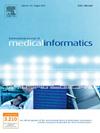IBDAIM:Artificial intelligence for analyzing intestinal biopsies pathological images for assisted integrated diagnostic of inflammatory bowel disease
IF 4.1
2区 医学
Q2 COMPUTER SCIENCE, INFORMATION SYSTEMS
International Journal of Medical Informatics
Pub Date : 2025-06-23
DOI:10.1016/j.ijmedinf.2025.106024
引用次数: 0
Abstract
Background
Inflammatory bowel disease (IBD), including Crohn’s disease (CD) and ulcerative colitis (UC), is challenging to diagnose accurately from pathological images due to its complex histological features. This study aims to develop an artificial intelligence (AI) model, IBDAIM, to assist pathologists in quickly and accurately diagnosing IBD by analyzing whole-slide images (WSIs) of intestinal biopsies.
Methods
This retrospective cohort study used data from two institutions, Nanjing Drum Tower Hospital (NDTH) and Zhujiang Hospital (ZJH). The NDTH dataset was randomly divided into a model development set and an internal test set, while the ZJH dataset served as an external validation set. We developed a weakly supervised deep learning model, IBDAIM, that uses WSI-level diagnostic labels without detailed annotation. The model integrates features from patch-level predictions using Patch Likelihood Histogram (PLH) and Bag of Words (BoW) to build WSI-level representations. Performance was evaluated using area under the receiver operating characteristic curve (AUROC), accuracy (ACC), sensitivity, and specificity. Probability plots and heatmaps were generated to analyze and visualize the diagnostic labels and organizational results of WSIs. Additionally, the model was applied to assist pathologists in diagnosis, and the improvement in diagnostic performance was assessed.
Results
In the normal intestinal mucosa vs. IBD task, the internal test cohort achieved an AUROC of 0.998 (95% CI 0.995–1.000) and ACC of 0.982, while the external test cohorts achieved an AUROC of 0.967 (95% CI 0.939–0.995) and ACC of 0.934. For the CD vs. UC task, the internal test cohort achieved an AUROC of 0.972 (95% CI 0.942–1.000) and ACC of 0.901, and the external test cohorts achieved an AUROC of 0.952 (95% CI 0.923–0.982) and ACC of 0.949. The model’s performance exceeded that of five pathologists, and AI assistance significantly improved diagnostic accuracy across all pathologists.
Conclusion
The IBDAIM model demonstrates high performance in diagnosing IBD biopsy pathological images and can effectively assist pathologists in identifying normal intestinal mucosa, CD, and UC tissues. This AI tool enhances diagnostic efficiency and accuracy, supporting better clinical decision-making and patient outcomes.
IBDAIM:用于分析肠道活检病理图像以辅助炎症性肠病综合诊断的人工智能
炎症性肠病(IBD)包括克罗恩病(CD)和溃疡性结肠炎(UC),由于其复杂的组织学特征,很难从病理图像中准确诊断。本研究旨在开发一种人工智能(AI)模型IBDAIM,通过分析肠道活检的全切片图像(WSIs)来帮助病理学家快速准确地诊断IBD。方法采用南京鼓楼医院(NDTH)和珠江医院(ZJH)两所医院的回顾性队列研究。NDTH数据集随机分为模型开发集和内部测试集,ZJH数据集作为外部验证集。我们开发了一个弱监督深度学习模型IBDAIM,它使用wsi级别的诊断标签而没有详细的注释。该模型利用补丁似然直方图(Patch Likelihood Histogram, PLH)和词袋(Bag of Words, BoW)集成补丁级预测的特征,构建wsi级表示。使用受试者工作特征曲线下面积(AUROC)、准确性(ACC)、敏感性和特异性来评估疗效。生成概率图和热图来分析和可视化wsi的诊断标签和组织结果。此外,应用该模型辅助病理学家进行诊断,并评估诊断性能的提高。结果在正常肠黏膜与IBD任务中,内部测试队列的AUROC为0.998 (95% CI 0.995 ~ 1.000), ACC为0.982;外部测试队列的AUROC为0.967 (95% CI 0.939 ~ 0.995), ACC为0.934。对于CD和UC任务,内部测试队列的AUROC为0.972 (95% CI 0.942-1.000), ACC为0.901,外部测试队列的AUROC为0.952 (95% CI 0.923-0.982), ACC为0.949。该模型的表现超过了五位病理学家的表现,人工智能的帮助显著提高了所有病理学家的诊断准确性。结论IBDAIM模型对IBD活检病理图像具有较高的诊断效能,可有效协助病理医师鉴别正常肠黏膜、CD和UC组织。这种人工智能工具提高了诊断效率和准确性,支持更好的临床决策和患者预后。
本文章由计算机程序翻译,如有差异,请以英文原文为准。
求助全文
约1分钟内获得全文
求助全文
来源期刊

International Journal of Medical Informatics
医学-计算机:信息系统
CiteScore
8.90
自引率
4.10%
发文量
217
审稿时长
42 days
期刊介绍:
International Journal of Medical Informatics provides an international medium for dissemination of original results and interpretative reviews concerning the field of medical informatics. The Journal emphasizes the evaluation of systems in healthcare settings.
The scope of journal covers:
Information systems, including national or international registration systems, hospital information systems, departmental and/or physician''s office systems, document handling systems, electronic medical record systems, standardization, systems integration etc.;
Computer-aided medical decision support systems using heuristic, algorithmic and/or statistical methods as exemplified in decision theory, protocol development, artificial intelligence, etc.
Educational computer based programs pertaining to medical informatics or medicine in general;
Organizational, economic, social, clinical impact, ethical and cost-benefit aspects of IT applications in health care.
 求助内容:
求助内容: 应助结果提醒方式:
应助结果提醒方式:


